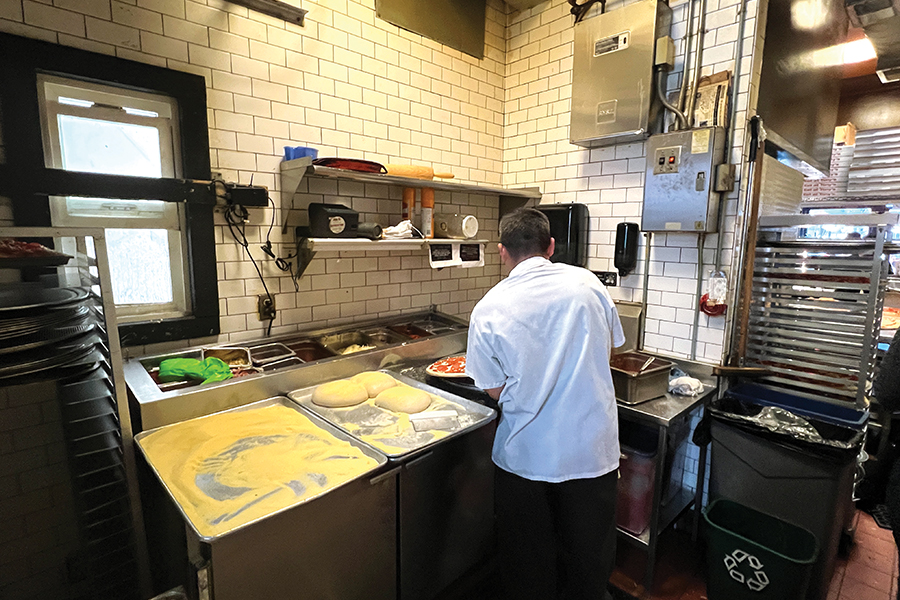Going Ghost
As the COVID-19 Pandemic shuttered dine in and off-premise sales soared, ghost and virtual kitchens gained ground. These operations exist solely for online delivery orders through websites, apps and third-party delivery platforms. Some marked them as the way of the future. During that time, Euromonitor estimated ghost kitchens could be a $1 trillion market globally by 2030.
The post-pandemic boom of indoor dining may have slowed the pace of the volume of ghost kitchen openings. You’re hearing less about the trend in restaurant news. Were ghost kitchens a fad or temporary solution to the pandemic? The short answer is no. The ghost model was increasing its frequency even before 2020. But the market forecast has changed and it’s growing at a sustaining pace. Though projections vary. The Global Cloud Kitchen Market is at $31.90 billion in 2022 and is anticipated to reach $117.89 billion by 2031, according to a new report from Astute Analytics. While ResearchandMarkets’s November 2022 release points to $58.13 billion in 2022 and is expected to grow to $89.5 billion in 2026.
We may have seen this trajectory before. Could ghost kitchens be following the fast-casual concepts rise? Fast-casual pizzerias came in red hot on the scene. The concepts that have perfected the segment and learned how to fit into the restaurant industry landscape are still thriving and growing. There have been business casualties along the way as the fast-casual pizza segment crossed the decade mark. Amidst the current turbulent restaurant climate, we have already seen some cautionary ghost and virtual kitchen failures, but success stories are abound too with models like CloudKitchens and Reef Kitchens.
Chuck E. Cheese may be the most well-known ghost kitchen case study in the pizzeria industry. The pizza and entertainment company was among the restaurant concepts hit the hardest by the pandemic’s indoor dining shutdown. Parent company CEC Entertainment Inc. launched the delivery-only virtual Pasqually’s Pizza & Wings in spring of 2020. Today the company website notes more than 450 ghost locations nationwide with online ordering available through its site and third-party delivery partners.
Ghost Ops
Ghost and virtual kitchens have their benefits. They come with lower start-up and operational costs, as well as typically lower labor cost through the use of automation technology. This provides established concepts the ability to gain a foothold in a new market and startups the chance to test concepts within given markets without the high overhead costs of a traditional brick and mortar. Just like any other restaurant businesses, they also have their drawbacks. Since ghosts are delivery only, they tend to carry high delivery service fees. Gaining marketing traction can also be a challenge, especially with customer loyalty. With multiple platforms delivering the product, there can be inconsistency with the customer experience.
To be successful in the ghost landscape, do your homework and get laser focused on the business planning just as you would a traditional restaurant. Let’s take a look at some ghost operation logistics if you are considering adding a ghost or virtual kitchen to your concepts.
First, there are three common forms of ghost operations. They are:
- Single Concept Delivery-Only Operation. These concepts are often referred to as ghost because there is no customer-facing component, often no signage, and orders go through third-party delivery services.
- Shared Kitchen. Think of this as a food production facility, often with several concepts operating in one kitchen or building. We’ve seen this model used in another form as joint commissary kitchens. They can also be referred to a virtual food halls.
- Virtual Kitchen. A virtual kitchen operates in an existing restaurant facility with a different brand that is delivery-only. This is the most common for established restaurants who want to enter the ghost market and test a different product or a certain menu product as a stand-alone business.
There are several things you should know before you dive into starting up a ghost kitchen. Here are just some the logistics you’ll need to nail down to succeed as a ghost operation.
Select a menu that can thrive in a delivery-only format. When deciding on a menu, selecting items that hold and delivery well. You also may want to focus only high margin items.
Know your market. Customer insights are vital. Do the market research and find the right customer demographic for the new ghost brand.
Location. Location. Location. Even though it’s a ghost operator, location is important to being in the right delivery zone for the customers you want to attract. Whether you are setting it up in a shared environment or in an existing restaurant, evaluate if the location is optimal for the specific products you want sell in the ghost environment.
Obtain all proper permits, licenses and follow all health and safety requirements. This is no different than your current restaurant. You must contact local and state entities to operate a ghost kitchen. Processes and rules vary by states and localities.
Make the right delivery decisions for you. Some operations have their own delivery program and others use third-party or both. A majority select to only delivery through third-party delivery platforms. Research and find the right delivery partners for your business.
Focus on your labor estimates. What is it going to take to staff your ghost operation efficiently and effectively? For those considering a virtual concept in an existing restaurant, ydon’t simply tack the ghost operation onto your existing team. Run the numbers and staff it properly.
Factor in supply chain and inventory. While a single-unit ghost kitchen may not have to worry about inventory as much, shared kitchens and virtual concepts have to consider how much product can be ordered and stored. This can directly impact your bottom line with supplier bulk pricing.
Denise Greer is the Executive Editor of Pizza Today.







